Thanks to the people who have contributed to this week’s newsletter: Ann Stanley, Bev Middleton, Biagio Pitruzzello, Cath Jones, Duang Tengtrirat, Hayden Marks, Julie French and Lynn Wallace.
This is the last newsletter for 2023. Seasonal greetings to everyone. Normal service will resume in early 2024.
The year in review
This newsletter
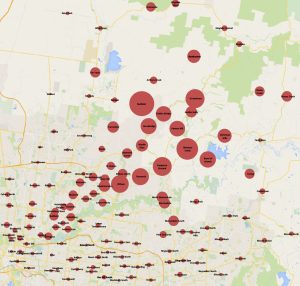 The newsletter is now in its 12th year, with me (Guy) as its editor for the last 9 years having taken over from the inimitable Robyn Currie.
The newsletter is now in its 12th year, with me (Guy) as its editor for the last 9 years having taken over from the inimitable Robyn Currie.
We began the year with around 4,000 subscribers. 44 newsletters later, we now have around 4,200 subscribers. So the numbers are still increasing, albeit at a slower rate than in previous years.
10% of the new subscribers live in Banyule, 10% in Darebin, 10% in Nillumbik, 35% in the other municipalities of North East Melbourne and the final 35% from further away.
The graphic shows the geographic distribution of newsletter recipients in the various suburbs of North East Melbourne, where the area of each red blob is proportional to proportion of the population in that suburb who are newsletter recipients.
The most clicked links in 2023 in various categories were as follows:
- Repeating event: The Really Really Free Market in Coburg.
- Non-repeating event: Leila Alexandra’s Awara open garden tours.
- External link: The best vanilla slices in Melbourne.
- Repeating website link: The jokes.
- Non-repeating website link: Jian Liu’s article about using spent coffee grounds.
Although the number of subscribers has almost doubled since before the pandemic (i.e. since 2019), the number of clicks of the event-related links in the newsletter now is no higher than in 2019 (in other words, people are, on average, clicking half the number of event-related links than they used to.). Read into this what you want but my impression is that behaviours have been changed either permanently or semi-permanently by the pandemic such that many people have become more home-based and less interested in events outside of their home.
Just about every newsletter contained at least one article on a food growing or food eating subject. This was only possible because of the regular contributions from Ann Stanley, Celesta Van der Paal, Jaimie Sweetman, Julie French, Megan Goodman and, last (in the alphabetical order) but certainly not least (in the contribution order), Robin Gale-Baker. Thanks to all of them!
Contributions from newsletter readers continue to greatly enrich the newsletters. Over the years, around 550 readers have made contributions. Again, thanks to all of them!
The website
The website is closely intertwined with the newsletter, with any new articles on the website being summarised in the newsletter and with most of the material from the newsletters also being somewhere on the website.
The number of people who visit the website roughly doubled during the pandemic and has remained at this level ever since, with roughly 400,000 people having visited the website over the last year. Around 50% of the visitors are from Melbourne, 30% from elsewhere in Australia and the final 20% from the rest of the world. Most of the visitors find the website by google searching and going to particular pages as a result.
The most popular page was, as always, the planting guide of what veggies to plant when followed by the page about food-related proverbs. In part because of her prodigious output, the most popular section is now Robin Gale-Baker’s growing guides.
There are now 130 producers in our Local Food and Drink Directory, 63 gardens with pages in our Community Gardening Directory, 30 swaps in our Food Swap Directory and around 40 organisations in our Food Justice Directory. All of the material has been approved by the relevant organisation and organisations are added as and when I (Guy) become aware of them and they respond positively to my communications with them.
Community gardens
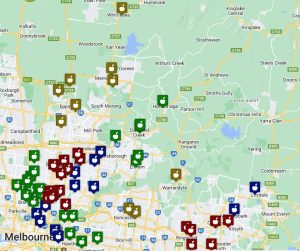 Community gardens are at the core of many of the community food-related activities across North East Melbourne and, as stated earlier, 63 of them have pages on our website.
Community gardens are at the core of many of the community food-related activities across North East Melbourne and, as stated earlier, 63 of them have pages on our website.
During the year, I became aware of 3 more community gardens, which now therefore have pages on our website, namely :
Many of the established community gardens continue to organise numerous events to which everyone is welcome, including:
- Croxton / Marra Guwiyap (Northcote).
- Edible Hub (Hurstbridge).
- Macleod.
- Oakhill (Preston).
- Regent (Reservoir).
- Reynard Street (Coburg).
- Sylvester Hive (Preston).
- SEEDs (Brunswick).
Many of these gardens also organise monthly food swaps.
The results for the Healthy Soils Competition for students (by Bev Middleton)
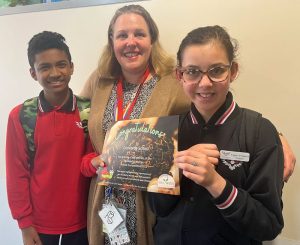 To celebrate both World Soil Day (5th December) and Soil Week (5th-12th December), Soil Week Australia, who are based in Macleod, recently ran a healthy soils competition. The competition aimed to raise awareness about the vital role of worms and life in the soil in maintaining soil health and the importance of carbon in the soil. The topic, wonderful worms, healthy soil and climate, attracted around 180 primary and secondary schools and students from across Australia who showcased their creativity through a variety of entries, including rap songs, murals, wiggly worm dances, comic strips and even an imaginative interview with a worm.
To celebrate both World Soil Day (5th December) and Soil Week (5th-12th December), Soil Week Australia, who are based in Macleod, recently ran a healthy soils competition. The competition aimed to raise awareness about the vital role of worms and life in the soil in maintaining soil health and the importance of carbon in the soil. The topic, wonderful worms, healthy soil and climate, attracted around 180 primary and secondary schools and students from across Australia who showcased their creativity through a variety of entries, including rap songs, murals, wiggly worm dances, comic strips and even an imaginative interview with a worm.
Schools and students with winning entries in their category each won $500. Read the list of winning schools and students.
In our North East suburbs, entries from Concord School (Bundoora), Eltham East Primary School, Kew High School and Parade College (Bundoora and Preston) won prizes of $50 and $100 vouchers. There were also entries from Montmorency East Primary School, Montmorency Primary School and individual entries from students in Warrandyte.
The photo is of Sienna and Christiano with teacher Jodi from Concord School in Bundoora. Concord is a specialist school for students with special needs. Quite a number of their students submitted entries and won prizes and they also made a video.
Melbourne Bushfood’s bush food of the month – finger lime (Citrus australasica)
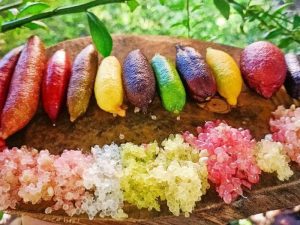 [The material below is a summary of material from the Melbourne Bushfood website. Melbourne Bushfood sells a wide range of bush foods (both the foods themselves and the plants) which you can buy either online or at their shop at 49 Sparks Avenue, Fairfield, Wednesday to Sunday, 10am-4pm.]
[The material below is a summary of material from the Melbourne Bushfood website. Melbourne Bushfood sells a wide range of bush foods (both the foods themselves and the plants) which you can buy either online or at their shop at 49 Sparks Avenue, Fairfield, Wednesday to Sunday, 10am-4pm.]
The innards of the finger-shaped finger lime fruit physically resemble caviar and taste not dissimilar to grapefruit or lime (i.e. sour citrus). You can use in sorbets, desserts or any other dish were citrus is needed. The fruit can also be either frozen or dehydrated.
There are lots of varieties, each with a different taste. The green varieties are more acidic and eucalypty, similar to limes, the red varieties are typically lighter in flavour with hints of grapefruit, and the yellow ones are more lemony.
The plant is a small tree growing up to 3 metres tall. Plant in full sun and use citrus fertiliser (rather than native fertiliser). You can also grow it in pots.
Harvest the fruit when mature. Mature finger limes are typically about 5-7cms long and 2cms in diameter. They should be plump, rounded and slightly soft.
Read about some other bushfoods on our website.
Pantalica Cheese
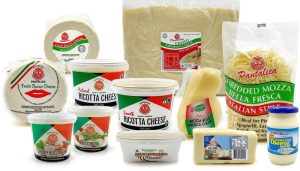 Established in 1973, the family owned and operated Pantalica Cheese Company, who are based in Thomastown, make a wide range of Italian cheeses, including bacio, bocconcini, halloumi, mascarpone, mozza bella fresca, parmesan and ricotta. Their milk is sourced from Gippsland. You can buy their cheeses from their shop (49-65 Trawalla Avenue, Thomastown, open Monday-Friday 8am-4pm and Saturday 8am-midday), online or at many IGAs.
Established in 1973, the family owned and operated Pantalica Cheese Company, who are based in Thomastown, make a wide range of Italian cheeses, including bacio, bocconcini, halloumi, mascarpone, mozza bella fresca, parmesan and ricotta. Their milk is sourced from Gippsland. You can buy their cheeses from their shop (49-65 Trawalla Avenue, Thomastown, open Monday-Friday 8am-4pm and Saturday 8am-midday), online or at many IGAs.
Read their page in our Local Food Directory (which includes a lot more photos).
Welcome Biagio, family and colleagues!
We now have 7 local cheese producers in our Local Food Directory.
More on future Thai food experiences
Apparently, Duang Tengtrirat is planning to run three more tours in July, August and September 2024. She is still finalising dates and other details, but you can email her at Nan.experience3@gmail.com to express your interest and get sent the information when it’s been finalised. Read Julie’s article about this year’s tour.
Duang will be on this week’s Gardening Australia
Duang’s and husband Rob’s garden in Castlemaine will apparently feature on Gardening Australia on Friday, 8th December.
CERES weed dating
As you may or may not know, CERES organise monthly ‘weed dating’ sessions where you meet new people whilst gardening. These events take place at Joe’s Market Garden in Coburg and you have to register your attendance.
These weed dating sessions were recently the subject of an article in The Guardian. Thanks for the heads up, Lynn Wallace!
Another video from Chloe Thomson
As part of her Behind the garden gate series, Chloe Thomson recently visited a garden in Hurstbridge. Watch the resulting video.
Ayurvedic cleansing green kitchari bowl (by Cath Jones)
[Despite its rather odd name, this lentil-based dish is actually really yum, which is why I asked Cath if I could include it in this newsletter. The recipe below is adapted from Leah Vanderveldt’s cookbook The New Nourishing and serves 4. For those of you who don’t know, ‘Ayurveda’ is an alternative medicine system with historical roots in the Indian subcontinent and ‘kitchari’ is a dish in Indian subcontinent cuisine made of rice and lentils.]
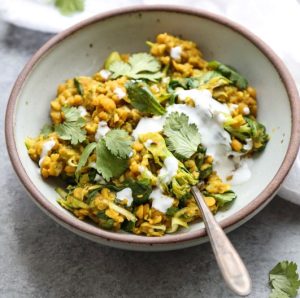 Ingredients
Ingredients
1 cup dried yellow split peas or lentils
½ cup long grain brown rice
3 tablespoons ghee or coconut oil
1 tablespoons grated fresh ginger
2 teaspoons ground cumin
1 teaspoon ground coriander
1 teaspoon fennel seeds
1 teaspoon ground fenugreek
1 teaspoon ground turmeric
1 teaspoon sea salt
5 cups vegetable stock or water
1 small crown broccoli finely chopped into an almost rice-like texture (about 2 cups total)
1 medium zucchini coarsely grated (about 1 cup)
1 cup packed baby spinach roughly chopped
¼ cup cilantro leaves
plain full-fat Greek yogurt for serving
Method
Rinse the yellow split peas or lentils and rice in a fine mesh colander under cold water until the water runs clear.
In a large lidded saucepan over medium-high heat, heat the coconut oil or ghee. Add the ginger and cook, stirring for 30 seconds. Add the cumin, coriander, fennel seeds, fenugreek and turmeric. Cook for another 30 seconds, until fragrant.
Add the split peas or lentils and rice and stir to coat in the spices. Add the salt and pour in the water or vegetable stock. Bring to a boil, cover, and reduce the heat to medium-low. Simmer for 35-45 minutes, stirring occasionally, until the peas/lentils are tender but not mushy and most of the liquid has been absorbed. (You may need to add more water if the mixture becomes to dry or begins to stick to the bottom of the pan).
Stir in the broccoli. Cover and cook for another 4-5 minutes. Stir in the zucchini and spinach, then remove from the heat and leave to stand for 5 minutes. Serve warm scattered with the cilantro and plain yogurt, if desired.
Note: to make it low FODMAP-friendly: Double the rice, skip the split peas or lentils, and omit the broccoli. And you can serve without the yogurt topping.
[We now have a total of 370 recipes on our website, all by local cooks. These recipes can be filtered by several factors, including author and main ingredients. So, for example, you can see that there are a total of 9 lentil-based dishes. If you have a recipe that you would be willing to share with the rest of us, simply email it to me]
Baking soda versus baking powder
I recently came across this article, which I thought was quite interesting. Here is what I learnt.
Baking soda is sodium bicarbonate (aka bicarbonate of soda). When it is brought into contact with an acid, a chemical reaction occurs that produces bubbles of carbon dioxide which, in turn, have a leavening effect.
Baking powder comprises a base (most commonly baking soda) plus a dry acid (most commonly cream of tartar) plus a buffer (most commonly corn starch) to stop the base and the acid interacting. When it is brought into contact with a liquid, the same chemical reaction occurs as for baking soda.
Most current baking powders produce further carbon dioxide when heated and are thus known as double-acting baking powders.
Wikipedia lists 3 common bases for baking powder and 9 common acids.
Baking soda and baking powder can potentially be substituted for each other but only if you know what you are doing.
Baking soda and baking powder work much more quickly than yeast and don’t produce any flavours. Although yeast also leavens through the production of carbon dioxide, the underlying chemistry is completely different.
Baking powder was invented in 1843 by someone called Alfred Bird, who was motivated to develop a yeast-free leavener because his wife was allergic to yeast. He also invented egg-free custard as his wife was also allergic to eggs. What a husband!
The Melbourne ‘Local Food Connections’ community radio show
The schedule for the balance of the year is as follows:
- Sunday, 10th December: Somer on food rescue.
- Sunday, 17th December: Guy Palmer on the local community gardens.
- Sunday, 24th December: Claire on permaculture principles 5-8.
- Sunday, 31st December: Claire on permaculture principles 9-12.
Listen on 3CR (855 AM) on Sunday mornings, 10-10.30am, by tuning into either the station (855 AM) or its livestream.
Podcasts of all previous episodes are available on their website. These are now proper podcasts, including titles and descriptions.
Which link was clicked most times in the last newsletter?
The most popular link in the last newsletter was the realestate.com.au for sale page for Panton Hill Winery.
Word of the month – Bletting
‘Bletting’, meaning the softening of certain fleshy fruits, such as medlars and persimmons, beyond ripening, until the desired degree of sweetness/palatability is attained.
Read about previous words of the month.
Proverb (or phrase) of the month
Salad days. Meaning: the exuberant days of one’s youth. Shakespeare invented this phrase to associate the fresh greenness of salad with the vigour and recklessness of youth. More specifically, in Antony and Cleopatra, Cleopatra used the phrase to explain away her early infatuation with Julius Caesar. Shakespeare was, perhaps, also contrasting the lightness of a dinner first course (Julius Caesar) with the richer and more substantial main course (Antony).
The phrase was the inspiration for the Monty Python spoof sketch Sam Peckinpah’s Salad Days, in which various carefree young things were hacked to pieces. Watch the sketch.
Read about more food-related proverbs.
Gardening quote of the month
“Every leaf speaks bliss to me, fluttering from the autumn tree.” by Emily Bronte.
 Joke (or pun) of the week
Joke (or pun) of the week
Our fruit and vegetable business recently went into liquidation. We now sell smoothies.
Regular activities over the coming week
Farmers’ and other food markets
- Friday: Community Grocer, Carlton and Farm Raiser farmgate (Bellfield).
- Saturday: Carlton, Coburg and Farm Raiser farmgate (Bellfield).
- Sunday: Alphington, Eltham and Whitehorse.
- Tuesday: Community Grocer, Fitzroy.
- next Wednesday: Really Really Free Market (Coburg).
Eltham Farmers’ Market will continue to take place on every Sunday throughout the festive season. The Christmas Eve and New Year’s Eve markets will, however, have unique trading times, with the Christmas Eve market being 7-10am and the New Year’s Eve market being 8-11am.
The three Melbourne Farmers Markets market (Alphington, Carlton and Coburg) will take place as per normal on the weekend before Christmas. Their plans for the weekend before New Year have not yet been announced.
Food swaps
- Saturday: Brunswick East, Hurstbridge, Mooroolbark and Willsmere Station.
- Sunday: zip.
Community gardens
- Thursday: Buna (Heidelberg West), Diamond Valley Library (Greensborough), Edible Hub (Hurstbridge), SEEDs (Brunswick) and Whittlesea.
- Friday: Reynard Street (Coburg) and West Brunswick.
- Saturday: Links (Lalor), Macleod, Northcote Community, Tables (Heathmont) and Thrive (Diamond Creek).
- Sunday: Fawkner Food Bowls, Pentridge (Coburg), Regent (Reservoir) and West Brunswick.
- Monday: Panton Hill, SEEDs (Brunswick) and Whittlesea.
- Tuesday: Diamond Valley Library (Greensborough) and Watsonia.
- Next Wednesday: Eltham Neighbourhood House, Macleod, Newton Street (Reservoir), Span (Thornbury) and Sylvester Hive (Preston) .
Upcoming face-to-face events – not cooking
In December
- Preparing for the summer harvest with Teresa Day; Wednesday, 6th December, 6.30-8.30pm; free; Doncaster.
- Forage walk; Saturday, 9th December, 10am-midday; $35 ($18 per hour); Coburg.
- DIY mushrooms; Saturday, 9th December, 10am-4pm; $175 ($29 per hour); CERES.
- Sustain and Oakhill Farm holiday barbecue; Thursday, 21st December, 5-8pm; free; Preston.
Regular events
- Beekeeping workshop; roughly once a month on Saturdays, 1-3.30pm; $85 ($34 per hour); Brunswick East.
- Carlton aperitvio food tour; every Friday, 5-7pm; $139 ($70 per hour); Carlton.
- Classic cocktails; various Tuesdays, 7-10pm; $70 ($23 per hour); Fitzroy.
- Edible Forest tours; every Friday and Saturday, 11am-1pm and again at 1-3pm; $25 ($13 per hour); Dixons Creek.
- Eltham trails (walking food tour); various Saturday mornings and Thursday evenings; $65 ($22 per hour); Eltham.
- Flavours of Coburg food tour; 3rd Saturday of each month, 10am-1pm; $65 ($22 per hour); Coburg.
- Gin making masterclass; most Saturdays, 10am-1pm; $175 ($58 per hour); Nunawading.
- Gin masterclass; most Saturdays and Sundays, midday-1pm; $80 ($80 per hour); Eltham.
- Wine tasting; various days, times and prices; Abbotsford.
Upcoming face-to-face events – cooking
In December
- Buche de noel workshop; Friday, 1st December, 6-9pm; $91 ($30 per hour); Lower Templestowe.
- Kombucha, jun, water kefir, wild mead and beet kvass; Friday, 1st December, 6.30-8.30pm; $180 ($90 per hour); Fitzroy North.
- Sourdough breadmaking; Saturday, 2nd December, 10am-12.30pm; $71 ($28 per hour); Lower Templestowe.
- Baking for Christmas; Saturday, 2nd December, 10am-2pm; free; Kilsyth.
- Authentic Mexican; Saturday, 2nd December, 10am-3pm; $120 ($24 per hour); CERES.
- Sourdough bread baking; Sunday, 3rd December, 9am-5pm; $190 ($24 per hour); CERES.
- Christmas tree cake class; Sunday, 3rd December, 1-4pm; $245 ($82 per hour); Diamond Creek.
- Gluten-free Christmas baking; Wednesday, 6th December, 10am-12.30pm; $35 ($14 per hour); Balwyn North.
- Get your dad in the kitchen!; Wednesday, 6th December, 4-6pm; free; Hawthorn.
- Hamed Allahyari – salamati; Wednesday, 6th December, 6.30-8pm; free; Fitzroy North.
- Indian cooking – Punjabi (2 sessions); Wednesdays, 6th and 13th December, both 6.30-8.30pm; $99 ($25 per hour); Hurstbridge.
- Gingerbread making with Mumma Sweden; Thursday, 7th December, 6.30-8.30pm; $70 ($35 per hour); Collingwood.
- Christmas cooking gift ideas; Friday, 8th December, 1.30-3pm; free; Greensborough.
- Gingerbread house for adults; Friday, 8th December, 6-9pm; $69 ($23 per hour); Lower Templestowe.
- St John’s Christmas gingerbread house making event; Friday, 8th December, 7.30-9.30pm; $40 ($20 per hour); Diamond Creek.
- No waste cooking demonstration with Open Table; Saturday, 9th December, 10-11am; free; Reservoir.
- Festive preserves; Saturday, 9th December, 10am-1pm; $81 ($27 per hour); Forest Hill.
- Christmas cookie creations; Saturday, 9th December, 10am-2pm; free; Kilsyth.
- Feta masterclass; Sunday, 10th December, 10am-3pm; $240 ($48 per hour); CERES.
- Gingerbread house decoration; Sunday, 10th December, 10.30am-midday; $50 ($34 per hour); Camberwell.
- Christmas cupcake class; Wednesday, 13th December, 10am-12.30pm; $145 ($58 per hour); Diamond Creek.
- Gingerbread house decorating workshop; Wednesday, 13th December, 1-3.30pm; free; Mill Park.
- Vegan chocolate making; Thursday, 14th December, 6.30-8pm; $80 ($53 per hour); Collingwood.
- Gingerbread house for children; Saturday, 16th December, 10-11.30am; $53 ($35 per hour); Lower Templestowe.
- Gingerbread cookie house workshop; Saturday, 16th December, 1-2.30pm; $65 ($44 per hour); Forest Hill.
- Gingerbread house decoration; Saturday, 16th December, 2-3.30pm; $50 ($34 per hour); Camberwell.
Regular classes
- Al dente cooking (Italian); most Saturdays, 9am-1pm; $155 ($39 per hour); Chirnside Park.
- BBQ classes; various days and times; $135-150 ($45-50 per hour); Brunswick East.
- Bread making; various Sundays, 8am-2pm; $230 ($38 per hour); Abbotsford.
- Brunswick Kitchen (many different classes); various dates, times and prices but mostly 2½ hours long and $120; Brunswick.
- Chocolate making and pastry classes for children; various days and times; various costs; Yarra Glen.
- Chocolate making workshop; various Thursdays, Fridays and Saturdays; $152 ($38 per hour); Blackburn.
- Kombucha brewing workshop; last Thursday of each month, 7-11pm; $49 ($12 per hour); Brunswick.
- La Cucina di Sandra (Italian); various evenings, 6.30-10.30pm; $120 ($30 per hour); Richmond.
- Margot & Montanez (alfajores biscuits); monthly on Sundays, 10am-1pm ; $109 ($36 per hour); Camberwell.
- Otao Kitchen (many different classes); various dates, times and prices but mostly 3 hours long and $197; Abbotsford.
- Rosa’s cooking classes (Italian); various Saturdays and Sundays, 10.15am-3pm; mostly $165 ($35 per hour); Bundoora.
- Sourdough bread workshop; roughly once a month on Saturdays, 9-11.30am; $185 ($74 per hour); Brunswick East.
- Tea blending; various Sundays; $75 ($60 per hour); Brunswick.
- The ultimate biscuit class; various Tuesdays, 10am-3pm; $162 ($32 per hour); Blackburn.
